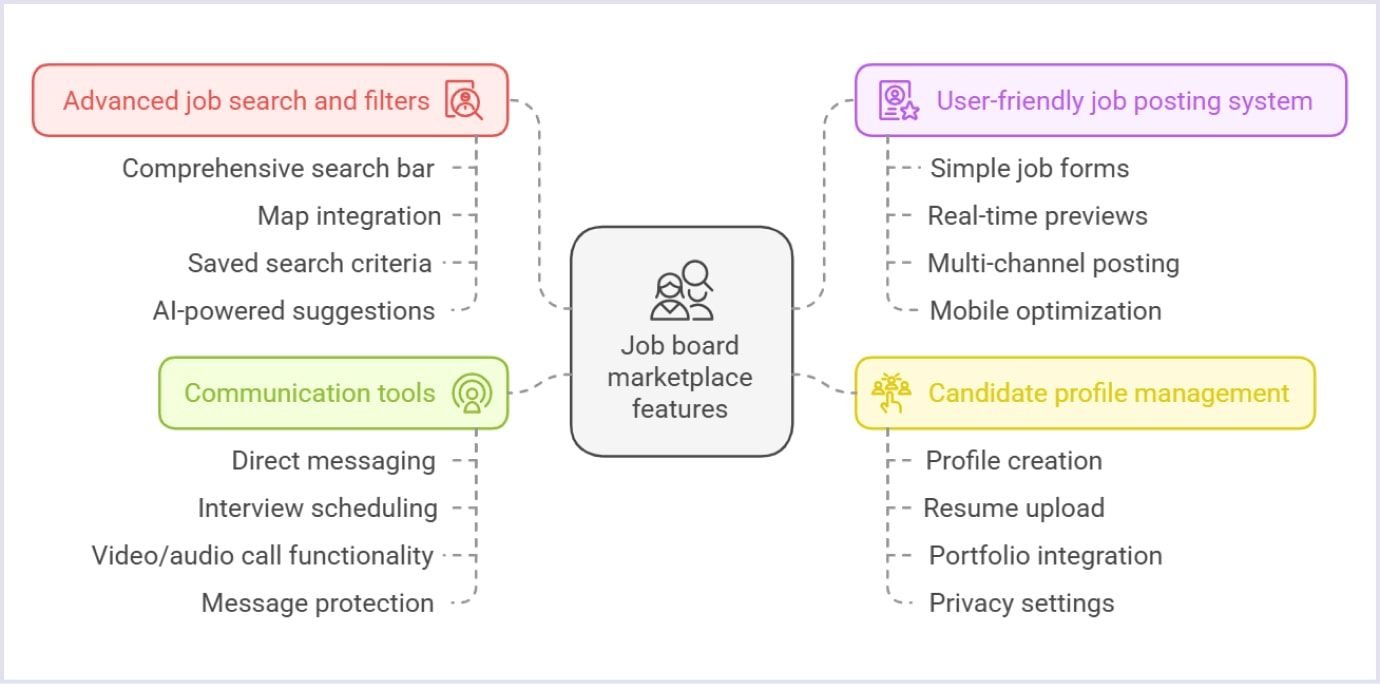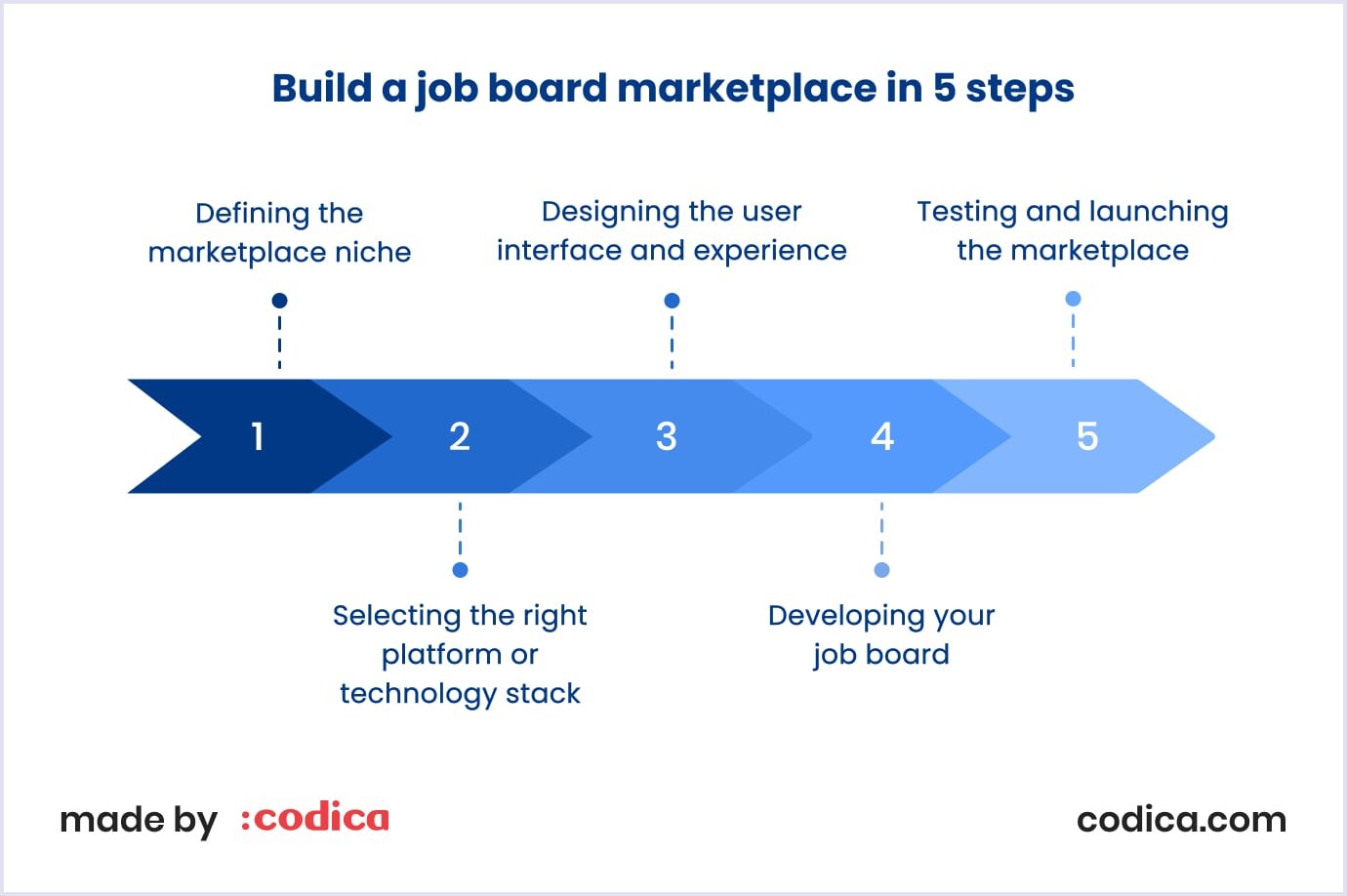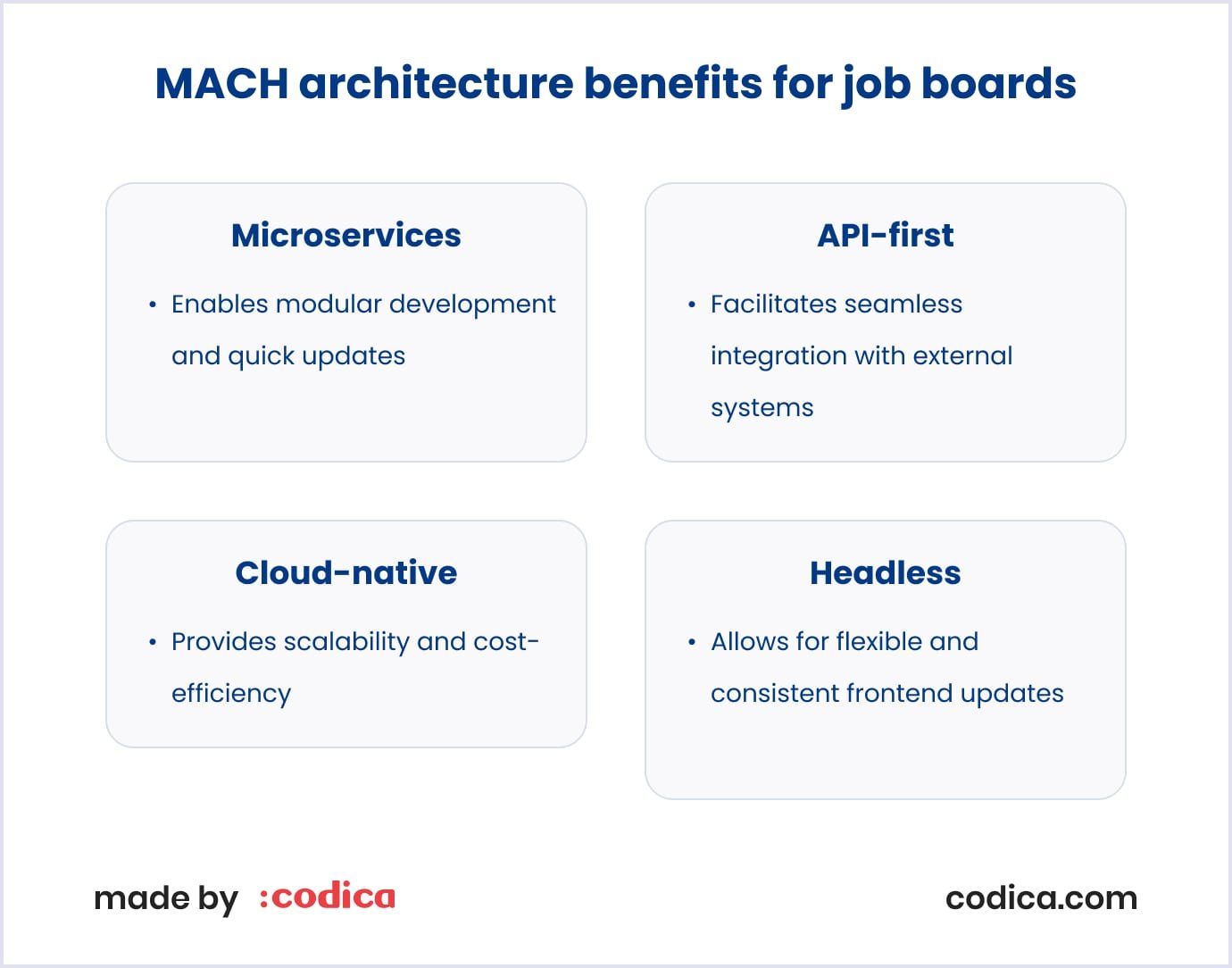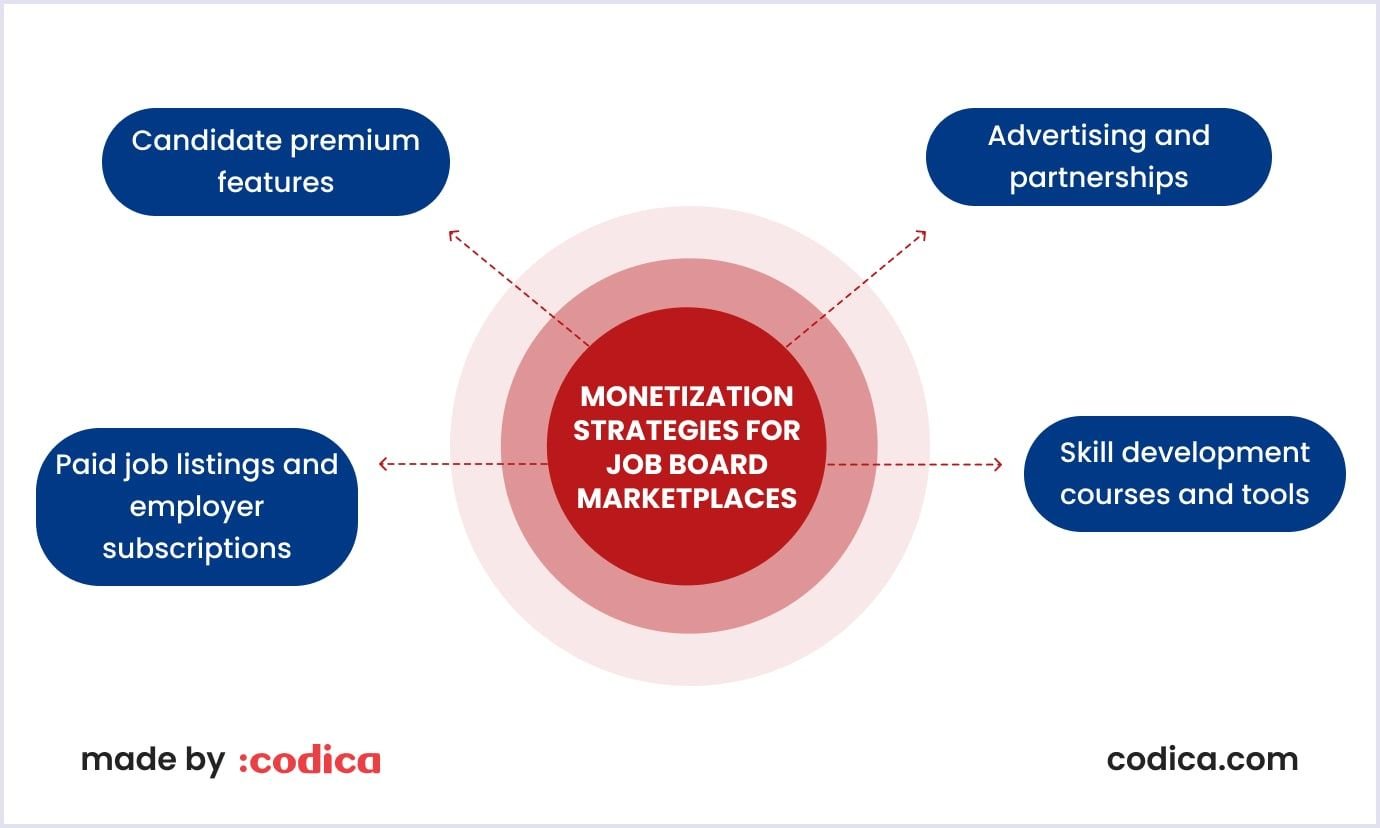Job boards work for both sides: candidates and employers. With the coverage that job boards provide and today’s technologies, both parties get a simplified process of finding a match.
Yet, the job board marketplace development should be approached carefully as you are about to compete with many other similar marketplaces. Also, your platform must be in line with modern technical advancements and data protection standards to become a success.
In this article, we provide you with a brief step-by-step guide as to how you can develop your marketplace for job search. You will find a description of development options, features, ways to monetize your marketplace, challenges, and solutions to them. Read on to learn more details from our experts.
Market overview for job board marketplaces
Job board marketplace is an online platform that connects employers and recruiters with job seekers. Such platforms provide advanced features for creating and managing profiles and job postings, offer assistance in upskilling, highlight the right candidates, and more.
Nowadays, people are looking for a job, but it’s hard to find one. Hence, employers and candidates need platforms to get wider outreach and potential opportunities. That’s why creating a job board platform is a profitable idea, even considering the challenges.
The job board aggregator market was valued at $5.2 billion in 2023 and is projected to grow up to $16.2 billion by 2032 at a CAGR of 13.7% from 2024 to 2032. Currently, the leaders are Indeed, LinkedIn, Glassdoor, ZipRecruiter, Monster, CareerBuilder, Dribbble, Dice, and others.
Below, we provide a brief overview of the opportunities and challenges in this market to help you thrive with your job board marketplace idea.
| Job board market breakdown for 2025 | ||
| Driving factors |
| |
| Restraining factors |
| |
| Opportunities |
| |
| Challenge |
| |
Core functionality to make your job board a success
The key features should ensure that your customers will achieve their goals. So, basic functionality for an online recruitment marketplace should allow job seekers and employers to connect easily. Here are the basic features that will ensure that your marketplace is an engaging place for both sides and provides fruitful job-matching opportunities.

Advanced job search and filters
The search allows candidates to find vacancies based on a particular skill set and specific parameters. To ensure the right connections for job seekers, consider including the following aspects in your advanced job search and filters:
- Comprehensive search bar. It should enable users to enter keywords, job titles, and company names and provide autosuggestions;
- Search integration with maps. The feature helps highlight nearby opportunities and offer filters by city, state, or remote-only roles;
- Saving search criteria. They will appear later when users return to a similar search;
- Personalized job suggestions. They can be powered by AI and remember user preferences and past interactions.
User-friendly job posting system
This feature ensures employers can post, remove, and manage listings depending on their hiring needs. By simplifying the process, you can make the posting system an intuitive and efficient tool to find the right talent.
Here is what to add to achieve that:
- Simple forms. They allow employers to specify job details, like title, description, requirements, and location;
- Templates and autofill options. These can be reused for recurring postings;
- Real-time previews. This feature allows employees to see how their listings will appear before publishing;
- Multi-channel posting. It helps employers reach multiple platforms and social media directly from your job board;
- Bulk posting options. They enable posting via employers’ HR systems;
- Mobile optimization. This way, you optimize your job board for job search and posting on mobile devices;
- Flexible payment options. These ensure that your customers can easily pay for premium subscriptions, sponsored listings, and other paid features.
Read also: How to Build a Recruitment App in 2025: Cost, Timeline, and Best Practices
Candidate profile management
This feature allows job seekers to showcase their skills and experiences. On the other hand, employers can access well-structured and concise user profiles. Below are the aspects you can include in candidate profile management on your job board:
- All-in-one profile. Basic elements of the profile form should include name, contact details, professional title, work experience, skills, and education;
- Resume management systems. Include support of various resume document formats and enable parsing to reflect resume data in the candidate’s profile;
- Portfolio integration. It should help candidates showcase their work samples and portfolio websites;
- Customizable privacy. For this, offer adaptable privacy settings and full or partial profile visibility;
- Updates. They should show changes that sync in candidates’ and employers’ profiles;
- Integrations with other job boards. Enable employers and candidates to publish their information on different job boards, like LinkedIn, Monster, and Indeed. Thus, your users get better exposure and prompt profile updates on various job platforms;
- Centralized dashboard. It is a helpful instrument for tracking jobs applied, application statuses, and upcoming interviews for candidates. On the other hand, employers can see the dynamics of their listings and hiring process.

Communication tools
Streamlined communication on a job board marketplace ensures that candidates and employers will be able to clarify necessary questions. Your job board should support candidate and employer communication via different channels for users’ convenience and an easy job-matching process. Consider including the following features for communication:
- Direct messaging with the possibility of organizing conversations in threads for future references and follow-ups;
- Customizations for the preferred channels of communication;
- Real-time updates on messages, application statuses, new job postings, and interview invitations;
- Interview scheduling tools with sending interview invitations and integration with planning tools, such as Google Calendar;
- Built-in video or audio call functionality for remote interviews with support for one-on-one and panel interview formats;
- Sensitive data protection via encryption;
- Blocking options and features to report inappropriate messages.
A step-by-step guide to building a job board marketplace
Whether you develop a job board marketplace yourself, with your team, or with a digital consultancy, knowing the basic steps will simplify things for you. Below, we discuss the core steps to make your job board idea a reality.

Step 1: Defining the marketplace niche
Finding a marketplace niche is a win in several ways. It’s a business you can build around a specific industry, demographic group, or location. So, you gain a particular identity that covers the needs unmet by general marketplaces.
For example, Health eCareers targets health professionals, AirlineJobs focuses on the aviation industry, and AbilityJOBS covers jobs for people with disabilities.
Here is what you can do to find a niche for your job board:
- Outline the type of career seekers and employers you want to attract, such as healthcare workers, entry-level candidates, or employers in a certain location;
- Analyze trends and pain points in existing job boards, such as poorly curated listings or struggles to find professionals in a specific niche;
- Ensure your niche has sufficient demand to sustain your platform;
- Define your unique value proposition, such as exclusive AI features for process automation or community forums;
- Plan for scalability as your job board evolves.
At Codica, we analyze your idea’s business potential during product discovery sessions. Our team considers your business goals, competition, target audience, and feature set. Based on this analysis, you get estimates, suggestions, and prototypes for your project.
The video below highlights the results that you will get after the product discovery phase with our team in more detail.
Step 2: Selecting the right platform or technology stack
Basically, you can choose between a solution with pre-built elements or a custom development. With a job board website builder, you can try and see how your job board resonates with your target audience. Yet, it may bring complications with customization and scalability. To build job boards, you can use JobBoard.io, Joomla’s job board extensions, Smartjobboard, and Strikingly.
On the other hand, if you choose custom software development, you will have greater flexibility in growing your marketplace. You can start with a minimum viable product (MVP), get user feedback, and plan for further growth.
In this case, we recommend proven technologies for building a job board marketplace. At Codica, we use TypeScript and Next.js / React for the frontend side and Ruby and Ruby on Rails for the backend.

Step 3: Designing the user interface and experience
This step is crucial to ensure that users will enjoy your job board and reach their goals with it. User experience (UX) helps them navigate your marketplace and find and customize features as they need. User interface (UI) is where you convey your brand identity with styles.
To help you with user-friendly job platform design, here are tips from our expert UI/UX design team:
- Understanding your users. Let job seekers easily find and apply for jobs, and employers streamline job posting and hiring process;
- Mobile responsiveness. Ensure that your marketplace is displayed correctly across different screen sizes. Mobile app development can also add convenience to using your job board;
- Intuitive functionality. Create menus and navigation bars that are easy to use and key sections can be reached within one or two clicks;
- Consistency in visual design. Your brand colors and styles should be consistent across the platform. Also, the contrast should improve elements’ visibility and accessibility.
Step 4: Developing your job board
The job board development process means embodying the job board vision formed in product discovery and design steps. At this stage, developers put the design guidelines into frontend development and implement business logic when developing the backend.
Basically, the process involves several teams that coordinate the development. So, developers, designers, DevOps engineers, and project managers interact to ensure the solution meets the client’s requirements.
At Codica, we start development with the inception phase, where we discuss the client’s business goals, job board marketplace requirements, and logical chains. For development, we create a staging environment and ensure that the processes are optimized with our DevOps services. We keep our clients informed and involved as it is necessary and preferable for them.
Step 5: Testing and launching the marketplace
While developing a marketplace, we test every feature. We will perform the final testing when the marketplace is ready. Thanks to our quality assurance services, the solution undergoes end-to-end, API, compatibility, security, and performance testing.
This comprehensive testing process ensures that your job board is ready for deployment. When launching your job board marketplace, consider a soft launch. That is, deliver your job board to a limited audience in a specific location or invite-only. Thus, you will be able to collect feedback on features and overall experience.
Recommended reading: How Automation Testing Increases Execution Speed, Test Coverage, and Effectiveness
Powering your job board with MACH architecture
Regarding the development of a job board marketplace, the MACH architecture is worth noting for its benefits. It is an approach that emphasizes composable and scalable architecture for marketplace solutions. The abbreviation stands for microservices, API-first, cloud-native, and headless. Let’s see how these principles make job boards future-proof.

Microservices for autonomous development
This part forms the backend modular structure. Thanks to microservices, your job board features are developed as separate components. For example, you can outline microservices for job search, filtering, user authentication, and payment systems.
Thanks to microservices, you get faster time-to-market, feature updates, and failures limited to specific services.
API-first for easy integrations
APIs (application programming interfaces) help your microservices communicate with the frontend and external systems. APIs gather only necessary data and send it to the microservices. The latter sends it to display on the frontend part.
With APIs, you can easily add job board payment integration, AI-powered job recommendations, and video interview tools.
Cloud-native to scale as needed
Another benefit of MACH solutions is that they are cloud-native. This means they are built and hosted in the cloud and win from the robust tools of Amazon Web Services (AWS), Azure, and Google Cloud.
Thanks to the cloud, your job board website scales as needed. Specific features under high traffic loads get more resources, if necessary, in the scalable job board architecture, which ensures optimized performance of your platform. Also, cloud services are cost-efficient as you pay for what you use.
Headless architecture for customization
In headless architecture, the frontend that displays the interface is separated from the backend. So, you can make changes to your interfaces across different channels without touching the backend. As a result, the frontend of your mobile app, social media, and website gets instant and consistent updates. Such flexibility gives you the freedom to implement your job board designs and interface updates.
You may also like: Securing Marketplaces with MACH: Best Practices and Strategies
Job board marketplace MVP: cost estimate
Planning the job board development involves budget allocation. The basic factors that form the job board development cost include developer hourly rates and the complexity of your solution. For example, in North America, mid-level developers charge $61-$100 per hour. In Western and Eastern Europe, the hourly rates go from $41 to $120 for this level of expertise.
To simplify the cost estimate for you, our team prepared the table below. It lists the core features of the job board MVP development and the time to develop them at a rate of $50 per hour.
| The cost to build a job board marketplace MVP | ||
| Features | Time, hours | Cost ($50/h) |
| Design | ||
| UX development | 64 | $3,200 |
| UI development | 80 | $4,000 |
| Architecture | ||
| Project setup | 16 | $800 |
| DB structure | 32 | $1,600 |
| Integrations | ||
| Payment (Stripe or PayPal) | 32 | $1,600 |
| Main functionality | ||
| Authorization and security | 32 | $1,600 |
| User profiles | 40 | $2,000 |
| Homepage | 48 | $2,400 |
| Notifications | 32 | $1,600 |
| Search and filters | 64 | $3,200 |
| Company reviews | 32 | $1,600 |
| Messenger | 32 | $1,600 |
| Company page | 48 | $2,400 |
| Job listings | 48 | $2,400 |
| Job posting | 48 | $2,400 |
| CV builder | 72 | $3,600 |
| Employers panel | 72 | $3,600 |
| Applicants panel | 72 | $3,600 |
| Admin panel | 96 | $4,800 |
| Non-development activity | ||
| Project management | 64 | $3,200 |
| Quality assurance | 64 | $3,200 |
| Code review | 32 | $1,600 |
| Total | 1120 | $56,000 |
Thus, the estimated cost for a job board MVP is around $56,000. Depending on your project’s requirements, your development partner will give you a precise quote.

Monetization strategies for job board marketplaces
As you plan your job board business to evolve, implementing the right monetization strategy is essential. Below, we give a brief description of the approaches to make your marketplace profitable.

Paid job listings and employer subscriptions
Employers will win from advanced features and enhanced visibility of their job postings. So, here are two possibilities that you can use:
- Sponsored job postings. In this case, paid listings get better visibility;
- Employer subscriptions. These can cover bulk job postings, access to candidate databases, and advanced analytics.
For example, Indeed offers Sponsored Job postings starting at $5/day or $150/month.
Candidate premium features
For the other side of your marketplace, candidates, you can outline paid features that will help them in the following:
- Improve the resume’s visibility on the top of employers’ search highlights;
- Access to exclusive postings or early application opportunities;
- Personalized career training, mock interviews, or resume reviews.
For example, Dribble offers premium subscriptions of $16 charged monthly or $8 per month charged yearly. In return, designers who search for jobs get no-fee transactions, a ranking boost in feeds, and advanced profile features.
Advertising and partnerships
Displaying ads and introducing affiliate programs and partnerships are a win-win for you and your job board users. These opportunities come like the following:
- Displaying banners of employers or career seekers;
- Highlighting services of recruitment agencies, HR software providers, or industry-specific organizations;
- Sponsored content, such as career advice articles and webinars.
For example, Lensa, a job search engine, partners with Appcast, a job site partnership company, to handle over $5 million in recruitment ads yearly. Thus, Lensa is efficient in managing bulk volumes of job advertisements.
Skill development courses and tools
While in a job search, candidates also try to upskill. Therefore, offering relevant courses and tools for extra payment is a source of revenue when monetizing job boards. The following are examples of how prominent job boards promote skill development courses and tools:
- LinkedIn Learning. LinkedIn offers LinkedIn Learning, a platform with thousands of courses. Candidates can improve their knowledge of leadership, technical skills, software proficiency, and more;
- Monster Career Center. It provides resume builders, learning materials, skill assessments, budget calculators, and more.

Challenges in building a job board marketplace and how to overcome them
Creating your job board is a starting point, and keeping it running comes with challenges. Below, we give you a breakdown of fundamental challenges and how to overcome them.
Attracting employers and job seekers
The problem with a starting marketplace is that one side is not willing to join it unless the other side joins and provides value to the platform. This is known as the chicken and egg problem. How can you overcome it?
According to Andrew Chen, a partner at Andreessen Horowitz, the supply side is king. In the case of a job board, employers provide value to your platform. Thus, attracting them first would be a wise move as part of your marketplace success strategies. For example, provide discounts for early adopters. Also, suggest free trials and premium features for free.
As for the career seeker side, you can spread the word about your job board in relevant communities and post job openings on social media. Also, you can partner with recruitment service providers to assist job seekers in their search.
Handling platform scalability
Job boards can experience spikes in traffic, for example, during major hiring campaigns. Here are several helpers to manage your platform’s scalability:
- Hosting your solution in the cloud helps you allocate resources to specific features;
- MACH architecture provides flexibility in steering loads to specific services;
- Caching, load balancers, and content delivery networks (CDNs) optimize the platform’s performance;
- Simulating high-traffic loads helps you identify weak spots and work on them before production.
Ensuring data security and compliance
Data security for job boards is a must as they process sensitive information of employers and candidates. Therefore, they must be protected against data leaks and breaches. Here is what will help you with that;
- Follow relevant guidelines on data protection, such as GDPR and CCPA;
- Use modern security methods, such as SSL encryption and secure login protocols;
- Monitor your platform with AI-powered tools to detect fake job postings or fraudulent accounts;
- Maintain regular security audits.
Codica’s experience in marketplaces and job-matching systems
Our team gained advanced experience in creating marketplaces and other solutions for businesses. We know how to combine proven and cutting-edge technologies to deliver the best solutions to our clients. Thanks to our online marketplace development services, companies improve their services and reach success.
For example, thanks to our approach in development, an online travel marketplace gained $2mln worth of sales in the first year and raised its traffic by 385% over two years.
We also specialize in recruitment software. That is why when Wowner from the Netherlands turned to us, we were eager to help them create a job search website.
Our team analyzed the business goals and chose the tech stack to implement the necessary functionality. Namely, the project required an intelligent job search system and job seeker features. The system would analyze the candidate’s skills and match the career seeker with the right opportunities. If skills need improvement, the system offers relevant courses.
The solution for Wowner is mobile-friendly and provides job seekers with helpful features. They can manage their profiles, match jobs based on exact parameters, keep skill passports, and track performance with an insightful dashboard.
Watch the video below to see how the system works on mobile.
Check out our portfolio for more successful projects.
Wrapping up
Building a job board marketplace takes time and effort, even if you start small. Yet, with careful planning and the right strategy, you can ensure that your audience will be engaged with your platform.
If you have a job board project in mind, our team would be happy to help. Contact us, and our experts will guide you through the process.
